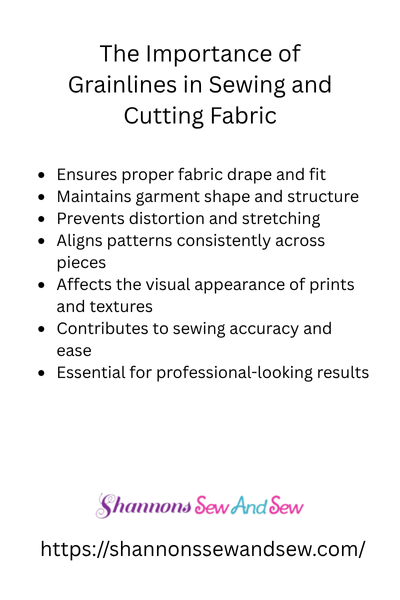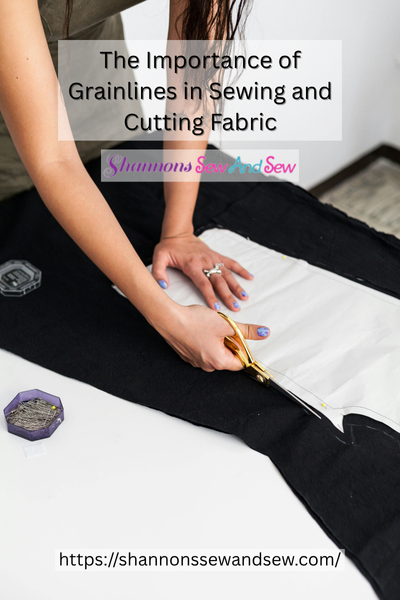Sewing Tips
The Importance of Grainlines in Sewing and Cutting Fabric
Let’s talk about something that seems small but has a massive impact on your sewing projects: the importance of grainlines in sewing and cutting fabric. If you’ve ever ended up with a wonky seam, a shirt that twists when you wear it, or pants that somehow don’t hang right—yeah, the grainline probably had something to do with it.
I’ll be real with you—I didn’t always pay attention to grainlines when I started sewing. I’d unfold the fabric, slap on my pattern pieces, cut away, and then wonder why my “masterpiece” looked more like a craft project gone rogue. Sound familiar?
Read More About The Importance of Grainlines in Sewing and Cutting Fabric

So, what is a grainline anyway?
The grainline is basically the direction your fabric threads run. You’ve got the lengthwise grain (runs parallel to the selvage), the crosswise grain (runs perpendicular), and the bias grain (that lovely 45-degree angle that gives fabric its stretch and drape).
When pattern pieces include a grainline arrow, it’s not just a decorative suggestion. That line tells you exactly how to align the pattern on the fabric for your garment to behave the way it’s supposed to. Ignore it, and you’re inviting chaos.
More Things to Know About The Importance of Grainlines in Sewing and Cutting Fabric

Why the importance of grainlines in sewing and cutting fabric can’t be overstated
Here’s where it gets juicy: that grainline controls how your finished project looks, fits, and moves. Cut a pair of pants off-grain and you might feel like one leg is always twisting around. Make a shirt where the torso is off-grain and suddenly your side seams are migrating to the front. It’s weird and uncomfortable—trust me, I’ve worn my fair share of homemade Franken-shirts.
When you honor the grainline, though, everything just… works. The fabric drapes right, your hems sit straight, and you get that crisp, professional finish—even if you’re a home sewer like me who works from a dining table.
A mistake I’ll never forget
Okay, here’s a quick story. I was making this button-up shirt for my brother. I was feeling confident, maybe a little too confident. I rushed through the layout and totally ignored the grainlines on the yoke pieces. Thought I was saving time—ha!
When he tried it on, the back of the shirt looked like it was trying to spiral around his body. It pulled in weird spots and the shoulders wouldn’t lay flat. He looked at me like, “Is it supposed to do this?” I had to laugh (and then unpick the whole thing and redo it the right way). That was the day I fully understood the importance of grainlines in sewing and cutting fabric.
How to actually use the grainline
Here’s the good news: it’s not hard once you know what to look for. You line up the arrow on your pattern with the lengthwise grain—which, again, runs parallel to the selvage edge. Use a ruler or tape measure to make sure both ends of the arrow are the same distance from the selvage. Pin it down and cut. That’s it. It takes a couple extra minutes but saves you hours of frustration.
If you’re working with knits, you’ve still got grainlines to think about. Knits have a bit more give, but cutting off-grain can still lead to stretched-out necklines or sleeves that don’t behave. And if you’re sewing on the bias? Oh man, things get flowy and fabulous—but also fiddly. The bias cut can give you amazing movement and drape, but you have to respect the direction of that grain or things will go haywire fast.
Don’t let grainlines intimidate you
If all this talk about fibers and directions feels overwhelming, don’t sweat it. It’s one of those things that makes more sense the more you sew. The first time you cut something off-grain by mistake, you’ll feel it (and maybe say a few choice words). But once you see how much better your projects turn out when you do follow the grainline? You won’t go back.
I still get a little nerdy thrill when I see a garment hang just right because I nailed the grainline. It’s one of those small details that separates “meh” from “nailed it.” And hey, if you’re putting in the time and effort to sew something from scratch, why not make it as awesome as possible?
Straight Grain Wins in Every Project Sewing and Cutting Fabric
So yeah, the importance of grainlines in sewing and cutting fabric is one of those “tiny but mighty” rules in sewing. It’s easy to overlook, especially when you’re excited to dive into a new project. But taking just a bit of time to align your pattern pieces with the grain can make the difference between a piece that looks handmade (in the bad way) and one that looks hand-crafted (in the awesome way).
If you’ve ever had a project go sideways—literally—it might be time to start giving grainlines the respect they deserve. Trust me, your future self (and anyone lucky enough to wear your creations) will thank you.




















